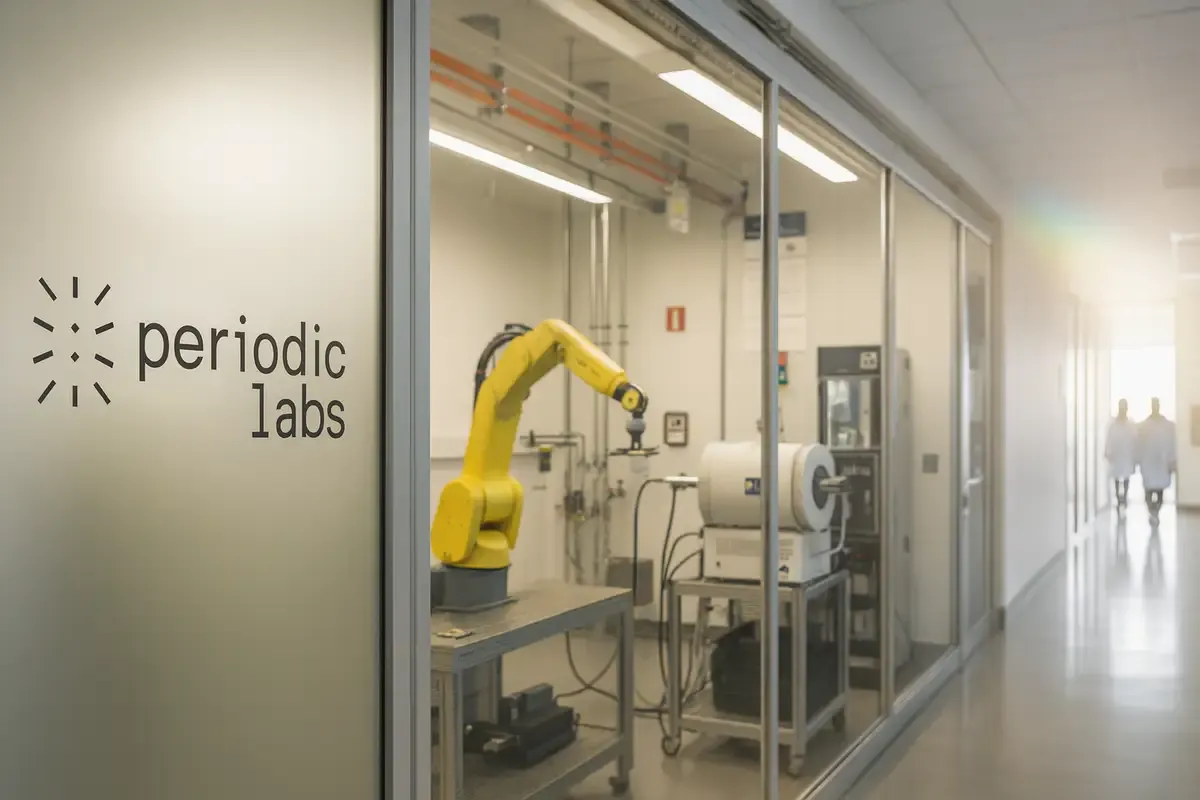💡 TL;DR - The 30 Seconds Version
👉 Periodic Labs closed a $300 million seed round led by Andreessen Horowitz to build AI scientists and autonomous labs that discover new materials through closed-loop experimentation.
🧪 Founded by Liam Fedus (OpenAI) and Ekin Doğuş Çubuk (DeepMind), the company targets superconductors as moonshots and thermal management materials for chips as near-term revenue.
🏃 More than 20 researchers left Meta's superintelligence team, OpenAI, and DeepMind to join—betting on shipping actual materials over benchmark improvements.
🏭 The company is staffing a Menlo Park facility with automation engineers and crystallographers to run thousands of experiments monthly, logging every outcome for proprietary data advantage.
⚖️ The core tension: venture capital expects software-speed results, but materials science moves at furnace speeds—synthesis, validation, and qualification take months or years.
🎯 Success hinges on delivering 1-2 materials with validated properties that beat baselines and survive third-party testing within 18-24 months to prove the loop works.
Former OpenAI and DeepMind researchers want fewer leaderboard wins and more working materials.
Amazon-sized hype meets lab reality. Periodic Labs has raised a $300 million seed round led by Andreessen Horowitz to build “AI scientists” and the autonomous facilities they need to plan, run, and learn from physical experiments. The pitch is simple to state and hard to execute: move faster from ideas to atoms, as documented in coverage of the $300 million seed.
The claim vs. the constraints
Big money usually chases software’s speed. Materials science moves with furnaces, fixtures, and failure modes. That’s the tension. Periodic says intelligence is necessary but not sufficient; the missing ingredient is an industrial-grade loop where models propose, robots synthesize, instruments measure, and planners improve. It’s not another chatbot. It’s a factory for hypotheses.
The founders, Liam Fedus (formerly OpenAI) and Ekin Doğuş Çubuk (formerly Google Brain/DeepMind), are explicit about targets and buyers. Superconductors are the moonshot. Thermal management for chips is the near-term wedge. Clear metrics help: conductivity, stability, manufacturability, and cost. That’s how you avoid the demo trap.
What’s actually new
Two things stand out. First, the data posture. Foundation-model startups compete on compute and talent; closed-loop science competes on proprietary experimental data, especially negative results that never reach journals. Each day a lab runs, the planner gets better at mapping cause to effect. That compounds.
Second, the operating model. Periodic is staffing Menlo Park like a fab, not a software shop. Automation engineers sit beside crystallographers. Schedulers keep furnaces and X-ray diffraction booked. A data backbone logs every parameter and outcome. It’s the kind of system where you fix issues with a torque wrench before you touch the Python.
This is deliberately unglamorous. And that’s the point.
Evidence and talent
The field has been converging on this direction. DeepMind’s GNoME step change showed how many candidate crystals you can predict. Lawrence Berkeley National Lab’s “A-Lab” showed that autonomy closes the loop from prediction to synthesis at nontrivial speed. Prediction is plentiful. Synthesis is scarce. Periodic is trying to industrialize the scarce part.
Talent is moving accordingly. More than twenty researchers from Meta, OpenAI, DeepMind, and others have reportedly joined. One notable defection: a senior scientist leaving a new “superintelligence” unit after months, opting to ship materials with measured properties instead of another benchmark bump. That tells you where some researchers see the action.
Advisers add signal, not gloss. Chemist Carolyn Bertozzi and physicists Steve Kivelson and Zhi-Xun Shen, alongside materials leaders Mercouri Kanatzidis and Chris Wolverton, bring judgment for when a promising diffraction pattern turns into something useful in a device. Advisory boards don’t run robots, but they can keep programs honest.
Where value could accrue
Defensibility lives in the loop. If Periodic runs thousands of experiments a month, logs outcomes with clean provenance, and keeps instruments humming, it will generate a data set no one else has. The moat thickens with every failed recipe and every borderline success that later scales. If the loop stalls, you’re left with expensive equipment and an excellent hiring page. Throughput is the difference.
There’s also a pragmatic go-to-market. Superconductors are iconic and unforgiving. Thermal interface materials are pragmatic and purchasable. A validated, higher-conductivity material that stays stable under cycle testing and survives a supply chain can license quickly. One or two wins would reprice the company. Not ten. One or two.
Competition won’t wait
DeepMind and academic partners have money, prestige, and momentum. Startups like Citrine Informatics, Orbital Materials, and Kebotix already sell data-driven tools into materials R&D. Emerald Cloud Lab proves remote, automated operations can scale in the life sciences. Recursion shows what vertically integrated biology can become—and how long it can take when atoms enter the chat.
Periodic isn’t alone. But it is early with a war chest big enough to buy time, instruments, and the people who make them behave.
Risks and timelines
Timelines are the hardest part. Venture investors like software-style cadences; furnaces cool when a part backorders. Some phases won’t synthesize at scale. Catalysts that look heroic for a week can poison in a month. Properties on pristine coupons can degrade on production lines. The founders’ own mantra cuts both ways: intelligence is necessary, not sufficient. Mechanical reliability, calibration drift, and supply chains will be the grind.
Credibility will come from artifacts, not preprints. Watch for a few signals over the next 12–18 months. Hiring that blends atoms and bits. Instruments installed and commissioned, not just ordered. Third-party tests on materials with property deltas that matter to buyers. And most of all, a partner deal where a discovery leaves the PDF and enters a product cycle. That flips the story from hype to throughput.
The bigger shift
If Periodic and peers succeed, AI competition will bend toward domain-specific loops anchored in the physical world. The winners won’t just scale parameters; they’ll scale instrument uptime, sample prep, measurement fidelity, and clean labels. Proprietary experimental data—especially the ugly, negative kind—becomes the moat. That’s a different kind of platform power.
It also pushes incumbents. If you own the models but not the matter, you’ll need partners who do. Or you’ll build your own labs. Either way, the center of gravity moves.
Why this matters
- AI value shifts from generic models to proprietary, real-world data loops that improve with every experiment.
- Materials with validated, buyer-relevant properties could turn a record seed into near-term revenue—and reset expectations for AI’s role in science.
❓ Frequently Asked Questions
Q: What does a "self-driving lab" actually do?
A: It's a closed loop where AI proposes experiments, robots execute the synthesis (mixing precursors, heating in furnaces), instruments measure properties like conductivity or stability, and the AI planner uses those results to design better next experiments. The goal is running thousands of experiments monthly without manual intervention, learning from both successes and failures.
Q: Why does this need $300 million when software startups launch on far less?
A: Physical labs are expensive. X-ray diffraction equipment, calorimeters, deposition tools, and reactors each cost hundreds of thousands to millions. Add robotics for handling samples, clean rooms, safety systems, facility buildout in Menlo Park, and consumables. Then staff it with crystallographers, automation engineers, and lab managers alongside ML researchers. Hardware scales differently than code.
Q: How is this different from DeepMind's GNoME work in 2023?
A: GNoME predicted 380,000 stable materials using AI but didn't synthesize most of them. Prediction is fast; making materials in a real lab with actual precursors, temperatures, and pressures is slow. Periodic is industrializing the synthesis and validation step at scale, not just generating candidate structures. That's where the commercial value lives.
Q: How long does it typically take to discover and commercialize a new material?
A: Traditionally, 10-20 years from initial discovery to market adoption. Self-driving labs aim to compress the discovery phase to months instead of years. But validation, scale-up, qualification for industrial use, and supply chain integration still take time. Battery materials face especially long cycles because manufacturers demand extensive safety and lifetime testing.
Q: Will Periodic sell the materials themselves or license the discovery platform?
A: Likely both, depending on the material. High-volume commodities like battery cathodes could become licensing deals with manufacturers. Specialized materials for niche applications might warrant Periodic producing and selling directly. Platform licensing to industrial R&D teams is another path. The business model will clarify as first materials reach validation milestones.








